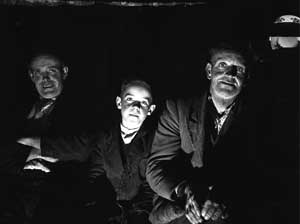KINDRED LINES: Evidence in folklore for Irish family history
Published in Features, Issue 5 (September/October 2022), Volume 30By Fiona Fitzsimons

Above: From the National Folklore Collection’s Photographic Collection—Paddy Deacy, Martin Cunnie, and Martin Deacy, Ballycashel, Co. Sligo, December 1955. (Leo Corduff)
The evidence we use in family history is not limited to archival records. We also use the evidence in our genes; the material culture around us (artefacts, gravestones, and photographs to name just a few); and in the family stories passed down. One source often overlooked by family historians, but which draws on two of these evidential strands—material culture and oral tradition—is the National Folklore Collection/Cnuasach Bhéaloideas Éireann. It documents Ireland’s ‘oral traditions, vernacular artefacts and customs, traditional music and song, along with beliefs and folk practise’. The core collection was assembled between 1935 and 1970, by full-time and voluntary collectors. It was continuously updated until 2005 and includes earlier (pre-1935) material. The archival holdings are made up of a number of separate collections:
Main Manuscript Collection Verbatim transcripts of field recordings, and collectors’ diaries with background information to interviews (names, places, dates). In the 1940s, voluntary collectors completed questionnaires, to ‘fill in’ gaps in the collection.
Photographic Collection Over 80,000 images of the people interviewed.
Schools’ Collection (1937-39) More than 50,000 primary school children, supported by their teachers, collected folklore in their home place.
Audio and Video Archives Collectors’ interviews. Much earlier material was taped over, and most audio recordings are from the 1940s.
Urban Folklore Project (1979-80). A record of the social history of Dublin City.
Folk Music Archive. Music recordings were in themselves a tangible cultural heritage. An almost complete survival of music recordings survives from 1935.
How is the National Folklore Collection relevant to family historians?
We will always find stories of the communities our ancestral families were from. This gives us an insight into the places with which they identified, and to which they had a sense of belonging. We can use the collection to explore the issues which most concerned people. The stories reflect the preoccupations and social values of Irish society, at any given time. Bad weather, crop failure, not being able to pay the rent, the fear of being evicted, and conflict with the authorities, are all common themes.
A better knowledge of customs and practises allows us to better interpret the evidence in the sources. Irish families scrupulously followed traditional naming patterns: the eldest son was named after his paternal grandfather; the second after his maternal grandfather; and the third after his father (if that name was not already in use). This practise was associated with the transfer of land from father to son(s). But there were specific circumstances when the traditional pattern was set aside. Where the farm/land was inherited by a daughter, known as a cliamháin, her husband was said to have ‘married into’ the farm. Then the first son of the marriage, was named after his maternal grandfather.
We often find stories where individuals or families of interest are named. Researching the family history of actress Maureen O’Hara, we found she descended from a family of hereditary blacksmiths in Kells, Co. Meath. The blacksmiths’ forge was a community hub, an alternative to the public house. The folklore collection tells us about O’Hara’s great-grandfather’s spirited involvement in local politics. Above all, the stories and oral histories in the folklore collection tell us about the texture of everyday life—how people acted, thought and felt on a daily basis. It is information we don’t find in the history books.
The National Folklore Collection is currently being digitised. It is possible to search online, by collection (main manuscript, schools, etc.); by theme (folk-medicine, settlement, dwelling, etc); by place (townland, parish, village, estate. The main collection also has an interactive map); and by names.
For a more detailed description of the collections see duchas.ie.
Fiona Fitzsimons is a director of Eneclann, a Trinity campus company, and of findmypast Ireland.
















